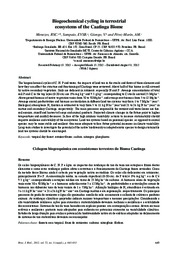Biogeochemical cycling in terrestrial ecosystems of the Caatinga Biome.
Biogeochemical cycling in terrestrial ecosystems of the Caatinga Biome.
Resumo: The biogeochemical cycles of C, N, P and water, the impacts of land use in the stocks and flows of these elements and how they can affect the structure and functioning of Caatinga were reviewed. About half of this biome is still covered by native secondary vegetation. Soils are deficient in nutrients, especially N and P. Average concentrations of total soil P and C in the top layer (0-20 cm) are 196 mg kg?1 and 9.3 g kg?1, corresponding to C stocks around 23 Mg ha?1. Aboveground biomass of native vegetation varies from 30 to 50 Mg ha?1, and average root biomass from 3 to 12 Mg ha?1. Average annual productivities and biomass accumulation in different land use systems vary from 1 to 7 Mg ha?1 year?1. Biological atmospheric N2 fixation is estimated to vary from 3 to 11 kg N ha?1 year?1and 21 to 26 kg N ha?1 year?1 in mature and secondary Caatinga, respectively. The main processes responsible for nutrient and water losses are fire, soil erosion, runoff and harvest of crops and animal products. Projected climate changes in the future point to higher temperatures and rainfall decreases. In face of the high intrinsic variability, actions to increase sustainability should improve resilience and stability of the ecosystems. Land use systems based on perennial species, as opposed to annual species, may be more stable and resilient, thus more adequate to face future potential increases in climate variability. Long-term studies to investigate the potential of the native biodiversity or adapted exotic species to design sustainable land use systems should be encouraged.
Ano de publicação: 2012
Tipo de publicação: Artigo de periódico
Unidade: Embrapa Semiárido
Observações
1 - Por padrão são exibidas publicações dos últimos 20 anos. Para encontrar publicações mais antigas, configure o filtro ano de publicação, colocando o ano a partir do qual você deseja encontrar publicações. O filtro está na coluna da esquerda na busca acima.
2 - Para ler algumas publicações da Embrapa (apenas as que estão em formato ePub), é necessário ter, no celular ou computador, um desses softwares gratuitos. Sistemas Android: Google Play Livros; IOS: iBooks; Windows e Linux: software Calibre.
Acesse outras publicações
Acesse a Base de Dados da Pesquisa Agropecuária (BDPA) para consultar o acervo completo das bibliotecas da Embrapa.

